NRSG370 Case Study: Holistic Care for DKA Patient Mr. Daniel Hughes
VerifiedAdded on 2023/04/23
|9
|2647
|355
Case Study
AI Summary
This case study analyzes the management of Mr. Daniel Hughes, a 28-year-old patient admitted to the High Dependency Unit (HDU) with diabetic ketoacidosis (DKA). The study explores the ethical, legal, and evidence-based considerations in providing holistic, patient-centered care, utilizing the clinical reasoning cycle. It covers the patient's history of type 1 diabetes, presenting symptoms, and relevant investigations. The nursing care plan addresses dehydration, elevated ketone and glucose levels, inflammation, and abnormal arterial blood gas results. Interventions such as fluid therapy and dextrose administration are discussed, emphasizing the importance of patient education and preventive measures to manage diabetes effectively and prevent DKA recurrence. The case study highlights the significance of continuous monitoring, adherence to ethical principles, and legal guidelines in nursing practice to ensure optimal patient outcomes.
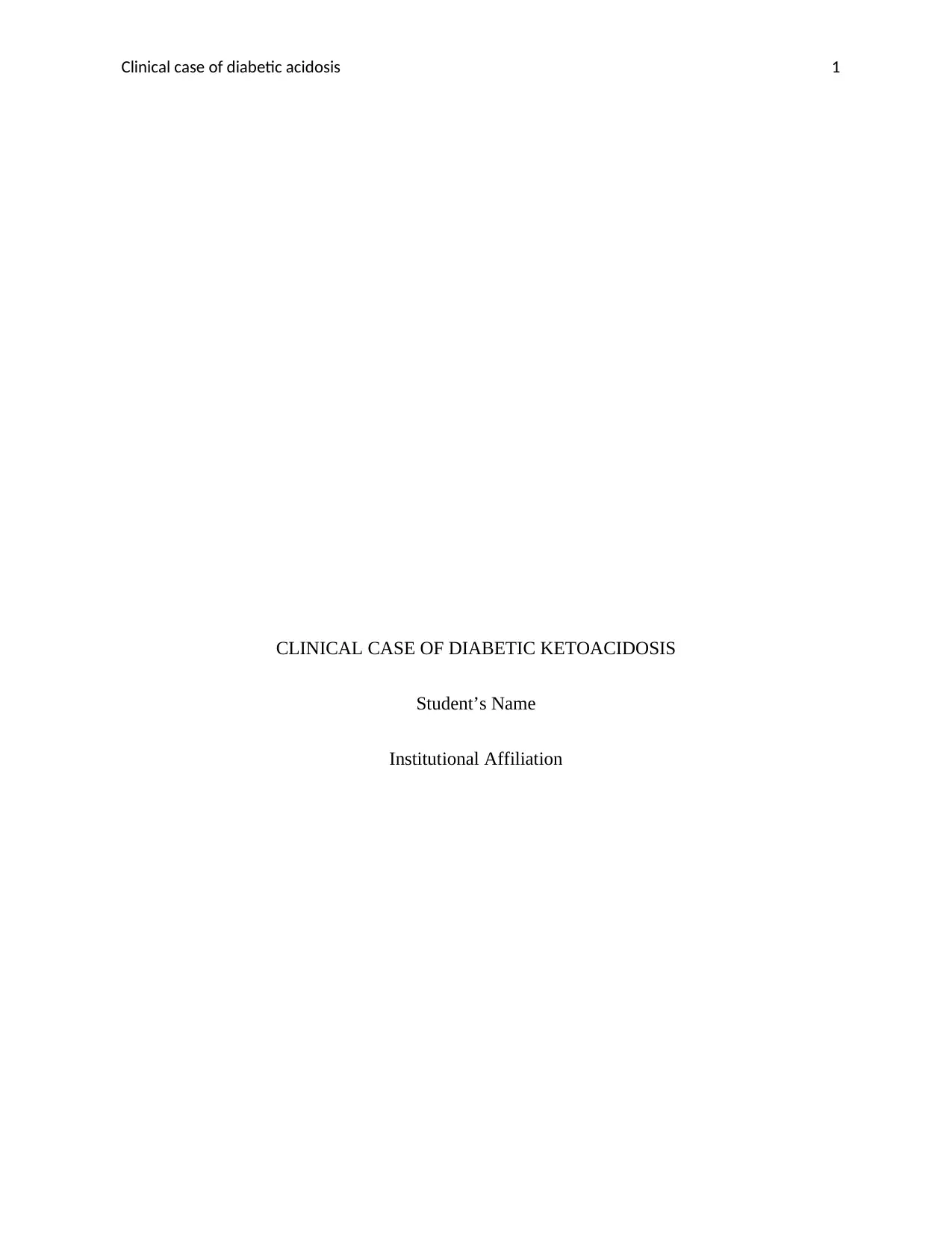
Clinical case of diabetic acidosis 1
CLINICAL CASE OF DIABETIC KETOACIDOSIS
Student’s Name
Institutional Affiliation
CLINICAL CASE OF DIABETIC KETOACIDOSIS
Student’s Name
Institutional Affiliation
Paraphrase This Document
Need a fresh take? Get an instant paraphrase of this document with our AI Paraphraser
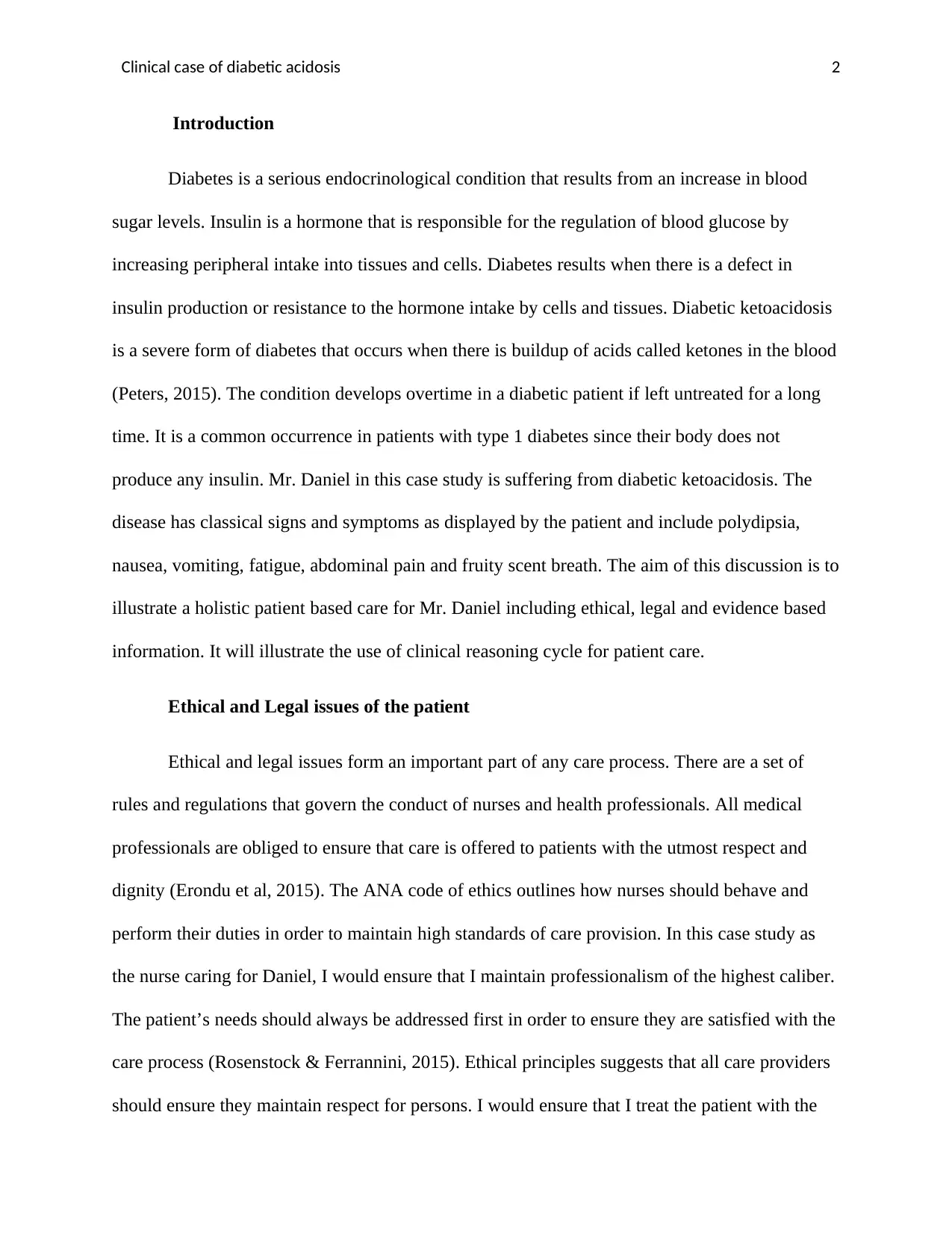
Clinical case of diabetic acidosis 2
Introduction
Diabetes is a serious endocrinological condition that results from an increase in blood
sugar levels. Insulin is a hormone that is responsible for the regulation of blood glucose by
increasing peripheral intake into tissues and cells. Diabetes results when there is a defect in
insulin production or resistance to the hormone intake by cells and tissues. Diabetic ketoacidosis
is a severe form of diabetes that occurs when there is buildup of acids called ketones in the blood
(Peters, 2015). The condition develops overtime in a diabetic patient if left untreated for a long
time. It is a common occurrence in patients with type 1 diabetes since their body does not
produce any insulin. Mr. Daniel in this case study is suffering from diabetic ketoacidosis. The
disease has classical signs and symptoms as displayed by the patient and include polydipsia,
nausea, vomiting, fatigue, abdominal pain and fruity scent breath. The aim of this discussion is to
illustrate a holistic patient based care for Mr. Daniel including ethical, legal and evidence based
information. It will illustrate the use of clinical reasoning cycle for patient care.
Ethical and Legal issues of the patient
Ethical and legal issues form an important part of any care process. There are a set of
rules and regulations that govern the conduct of nurses and health professionals. All medical
professionals are obliged to ensure that care is offered to patients with the utmost respect and
dignity (Erondu et al, 2015). The ANA code of ethics outlines how nurses should behave and
perform their duties in order to maintain high standards of care provision. In this case study as
the nurse caring for Daniel, I would ensure that I maintain professionalism of the highest caliber.
The patient’s needs should always be addressed first in order to ensure they are satisfied with the
care process (Rosenstock & Ferrannini, 2015). Ethical principles suggests that all care providers
should ensure they maintain respect for persons. I would ensure that I treat the patient with the
Introduction
Diabetes is a serious endocrinological condition that results from an increase in blood
sugar levels. Insulin is a hormone that is responsible for the regulation of blood glucose by
increasing peripheral intake into tissues and cells. Diabetes results when there is a defect in
insulin production or resistance to the hormone intake by cells and tissues. Diabetic ketoacidosis
is a severe form of diabetes that occurs when there is buildup of acids called ketones in the blood
(Peters, 2015). The condition develops overtime in a diabetic patient if left untreated for a long
time. It is a common occurrence in patients with type 1 diabetes since their body does not
produce any insulin. Mr. Daniel in this case study is suffering from diabetic ketoacidosis. The
disease has classical signs and symptoms as displayed by the patient and include polydipsia,
nausea, vomiting, fatigue, abdominal pain and fruity scent breath. The aim of this discussion is to
illustrate a holistic patient based care for Mr. Daniel including ethical, legal and evidence based
information. It will illustrate the use of clinical reasoning cycle for patient care.
Ethical and Legal issues of the patient
Ethical and legal issues form an important part of any care process. There are a set of
rules and regulations that govern the conduct of nurses and health professionals. All medical
professionals are obliged to ensure that care is offered to patients with the utmost respect and
dignity (Erondu et al, 2015). The ANA code of ethics outlines how nurses should behave and
perform their duties in order to maintain high standards of care provision. In this case study as
the nurse caring for Daniel, I would ensure that I maintain professionalism of the highest caliber.
The patient’s needs should always be addressed first in order to ensure they are satisfied with the
care process (Rosenstock & Ferrannini, 2015). Ethical principles suggests that all care providers
should ensure they maintain respect for persons. I would ensure that I treat the patient with the
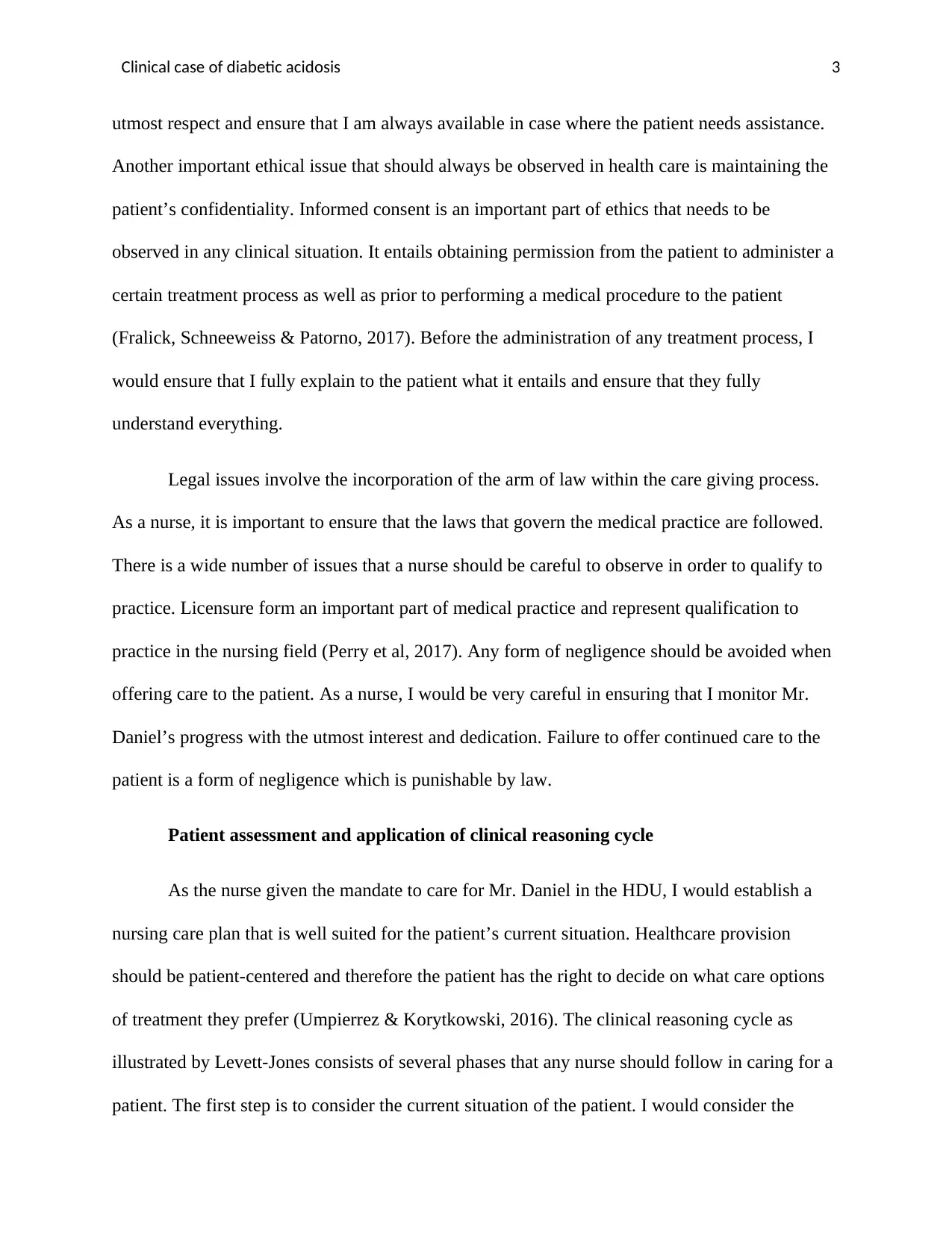
Clinical case of diabetic acidosis 3
utmost respect and ensure that I am always available in case where the patient needs assistance.
Another important ethical issue that should always be observed in health care is maintaining the
patient’s confidentiality. Informed consent is an important part of ethics that needs to be
observed in any clinical situation. It entails obtaining permission from the patient to administer a
certain treatment process as well as prior to performing a medical procedure to the patient
(Fralick, Schneeweiss & Patorno, 2017). Before the administration of any treatment process, I
would ensure that I fully explain to the patient what it entails and ensure that they fully
understand everything.
Legal issues involve the incorporation of the arm of law within the care giving process.
As a nurse, it is important to ensure that the laws that govern the medical practice are followed.
There is a wide number of issues that a nurse should be careful to observe in order to qualify to
practice. Licensure form an important part of medical practice and represent qualification to
practice in the nursing field (Perry et al, 2017). Any form of negligence should be avoided when
offering care to the patient. As a nurse, I would be very careful in ensuring that I monitor Mr.
Daniel’s progress with the utmost interest and dedication. Failure to offer continued care to the
patient is a form of negligence which is punishable by law.
Patient assessment and application of clinical reasoning cycle
As the nurse given the mandate to care for Mr. Daniel in the HDU, I would establish a
nursing care plan that is well suited for the patient’s current situation. Healthcare provision
should be patient-centered and therefore the patient has the right to decide on what care options
of treatment they prefer (Umpierrez & Korytkowski, 2016). The clinical reasoning cycle as
illustrated by Levett-Jones consists of several phases that any nurse should follow in caring for a
patient. The first step is to consider the current situation of the patient. I would consider the
utmost respect and ensure that I am always available in case where the patient needs assistance.
Another important ethical issue that should always be observed in health care is maintaining the
patient’s confidentiality. Informed consent is an important part of ethics that needs to be
observed in any clinical situation. It entails obtaining permission from the patient to administer a
certain treatment process as well as prior to performing a medical procedure to the patient
(Fralick, Schneeweiss & Patorno, 2017). Before the administration of any treatment process, I
would ensure that I fully explain to the patient what it entails and ensure that they fully
understand everything.
Legal issues involve the incorporation of the arm of law within the care giving process.
As a nurse, it is important to ensure that the laws that govern the medical practice are followed.
There is a wide number of issues that a nurse should be careful to observe in order to qualify to
practice. Licensure form an important part of medical practice and represent qualification to
practice in the nursing field (Perry et al, 2017). Any form of negligence should be avoided when
offering care to the patient. As a nurse, I would be very careful in ensuring that I monitor Mr.
Daniel’s progress with the utmost interest and dedication. Failure to offer continued care to the
patient is a form of negligence which is punishable by law.
Patient assessment and application of clinical reasoning cycle
As the nurse given the mandate to care for Mr. Daniel in the HDU, I would establish a
nursing care plan that is well suited for the patient’s current situation. Healthcare provision
should be patient-centered and therefore the patient has the right to decide on what care options
of treatment they prefer (Umpierrez & Korytkowski, 2016). The clinical reasoning cycle as
illustrated by Levett-Jones consists of several phases that any nurse should follow in caring for a
patient. The first step is to consider the current situation of the patient. I would consider the
⊘ This is a preview!⊘
Do you want full access?
Subscribe today to unlock all pages.

Trusted by 1+ million students worldwide

Clinical case of diabetic acidosis 4
presenting complains of the patient and assess the current needs of Mr. Daniel. Mr. Daniel
presented with vomiting, polydipsia and malaise. He had been brought in the hospital by the
mother and girlfriend indicating that his condition had worsened such that he could not seek
medical attention on his own. The characteristic symptoms had been visible for 2 days. In
regards to this, I would be interested to find out whether the patient sought any medical attention
or medication before being admitted to the hospital. This would help in identifying any
misdiagnosis and wrong medication as well as any side effects that could have risen from the
same.
Mr. Daniel was also recovering from a mild cold. This information is important in order
to ensure that the cold is managed and the patient recovers fully. The second phase requires a
nurse to collect information regarding the patient in order to process it and come up with the
right nursing diagnosis and care plan (Ogawa & Sakaguchi, 2016). Past medical history of any
patient is important as it provides clues to risk factors as well as prior similar complications. Mr.
Daniel in this case study has a 10 year type 1 diabetic history. He had been previously admitted
to the ICU for management of diabetic ketoacidosis in the past 5 years. He had an uneventful
appendicectomy 5 years and is a social drinker. In order to fully understand the patient and offer
the best care, there is need to process this information and link it to the pathophysiological
happenings of the condition.
Since type 1 diabetes occurs when there is no insulin production, the blood glucose levels
rise to levels above normal and cannot be regulated. Insulin is responsible for uptake of glucose
into cells and tissues from blood (Sharma et al, 2018). When this is not possible, cells opt to use
fats instead as fuel. The burning and breakdown of fat within the body is associated with ketone
production hence there is accumulation of ketones within the blood stream overtime that lead to
presenting complains of the patient and assess the current needs of Mr. Daniel. Mr. Daniel
presented with vomiting, polydipsia and malaise. He had been brought in the hospital by the
mother and girlfriend indicating that his condition had worsened such that he could not seek
medical attention on his own. The characteristic symptoms had been visible for 2 days. In
regards to this, I would be interested to find out whether the patient sought any medical attention
or medication before being admitted to the hospital. This would help in identifying any
misdiagnosis and wrong medication as well as any side effects that could have risen from the
same.
Mr. Daniel was also recovering from a mild cold. This information is important in order
to ensure that the cold is managed and the patient recovers fully. The second phase requires a
nurse to collect information regarding the patient in order to process it and come up with the
right nursing diagnosis and care plan (Ogawa & Sakaguchi, 2016). Past medical history of any
patient is important as it provides clues to risk factors as well as prior similar complications. Mr.
Daniel in this case study has a 10 year type 1 diabetic history. He had been previously admitted
to the ICU for management of diabetic ketoacidosis in the past 5 years. He had an uneventful
appendicectomy 5 years and is a social drinker. In order to fully understand the patient and offer
the best care, there is need to process this information and link it to the pathophysiological
happenings of the condition.
Since type 1 diabetes occurs when there is no insulin production, the blood glucose levels
rise to levels above normal and cannot be regulated. Insulin is responsible for uptake of glucose
into cells and tissues from blood (Sharma et al, 2018). When this is not possible, cells opt to use
fats instead as fuel. The burning and breakdown of fat within the body is associated with ketone
production hence there is accumulation of ketones within the blood stream overtime that lead to
Paraphrase This Document
Need a fresh take? Get an instant paraphrase of this document with our AI Paraphraser
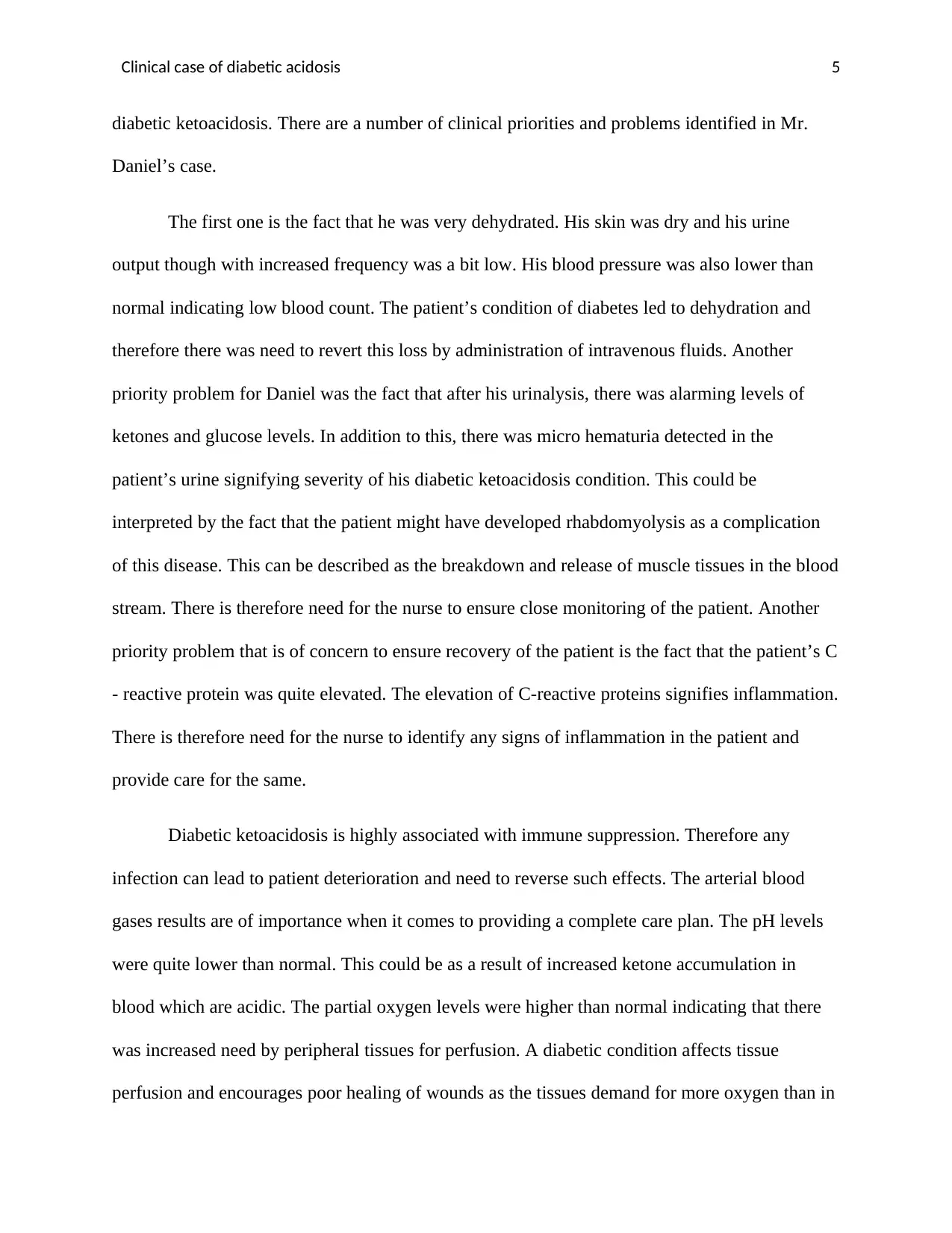
Clinical case of diabetic acidosis 5
diabetic ketoacidosis. There are a number of clinical priorities and problems identified in Mr.
Daniel’s case.
The first one is the fact that he was very dehydrated. His skin was dry and his urine
output though with increased frequency was a bit low. His blood pressure was also lower than
normal indicating low blood count. The patient’s condition of diabetes led to dehydration and
therefore there was need to revert this loss by administration of intravenous fluids. Another
priority problem for Daniel was the fact that after his urinalysis, there was alarming levels of
ketones and glucose levels. In addition to this, there was micro hematuria detected in the
patient’s urine signifying severity of his diabetic ketoacidosis condition. This could be
interpreted by the fact that the patient might have developed rhabdomyolysis as a complication
of this disease. This can be described as the breakdown and release of muscle tissues in the blood
stream. There is therefore need for the nurse to ensure close monitoring of the patient. Another
priority problem that is of concern to ensure recovery of the patient is the fact that the patient’s C
- reactive protein was quite elevated. The elevation of C-reactive proteins signifies inflammation.
There is therefore need for the nurse to identify any signs of inflammation in the patient and
provide care for the same.
Diabetic ketoacidosis is highly associated with immune suppression. Therefore any
infection can lead to patient deterioration and need to reverse such effects. The arterial blood
gases results are of importance when it comes to providing a complete care plan. The pH levels
were quite lower than normal. This could be as a result of increased ketone accumulation in
blood which are acidic. The partial oxygen levels were higher than normal indicating that there
was increased need by peripheral tissues for perfusion. A diabetic condition affects tissue
perfusion and encourages poor healing of wounds as the tissues demand for more oxygen than in
diabetic ketoacidosis. There are a number of clinical priorities and problems identified in Mr.
Daniel’s case.
The first one is the fact that he was very dehydrated. His skin was dry and his urine
output though with increased frequency was a bit low. His blood pressure was also lower than
normal indicating low blood count. The patient’s condition of diabetes led to dehydration and
therefore there was need to revert this loss by administration of intravenous fluids. Another
priority problem for Daniel was the fact that after his urinalysis, there was alarming levels of
ketones and glucose levels. In addition to this, there was micro hematuria detected in the
patient’s urine signifying severity of his diabetic ketoacidosis condition. This could be
interpreted by the fact that the patient might have developed rhabdomyolysis as a complication
of this disease. This can be described as the breakdown and release of muscle tissues in the blood
stream. There is therefore need for the nurse to ensure close monitoring of the patient. Another
priority problem that is of concern to ensure recovery of the patient is the fact that the patient’s C
- reactive protein was quite elevated. The elevation of C-reactive proteins signifies inflammation.
There is therefore need for the nurse to identify any signs of inflammation in the patient and
provide care for the same.
Diabetic ketoacidosis is highly associated with immune suppression. Therefore any
infection can lead to patient deterioration and need to reverse such effects. The arterial blood
gases results are of importance when it comes to providing a complete care plan. The pH levels
were quite lower than normal. This could be as a result of increased ketone accumulation in
blood which are acidic. The partial oxygen levels were higher than normal indicating that there
was increased need by peripheral tissues for perfusion. A diabetic condition affects tissue
perfusion and encourages poor healing of wounds as the tissues demand for more oxygen than in

Clinical case of diabetic acidosis 6
normal state (Taylor, Blau & Rother, 2015). The partial saturation of carbon (IV) oxide was
within normal range. However the bicarbonate levels were lower than normal. Bicarbonate offer
a good buffering effect and therefore when they are low this can affect the integrity of cells.
The establishment of goals after a theoretical analysis of the patient is important in
ensuring a holistic care provision. The patient in this clinical case presents with various
symptoms that require management. It is important to establish a treatment plan that focusses on
every single problem that is affecting the patient (Fadini, Bonora & Avogaro, 2017). The patient
on physical examination seemed restless, complained of thirst and showed signs of nausea and
vomiting. As the nurse in charge, I would ensure I prop the patient up to a more
comfortable position in order to reduce his restlessness. This can be important in assessing
the whether the patient has dyspnea and how severe it is. A medication plan to suppress the
nausea and vomiting is an important step in ensuring positive outcomes in the patient’s care. This
includes assessing the need for antiemetics in order to suppress the vomits.
Administration of the correct nursing care plan that covers every aspect of the patient is
of importance. The correct nursing interventions and their rationales form the basis of nursing
care (Goldenberg et al, 2016). For Mr. Daniel’s case, one of the important nursing
intervention would be to administer fluid therapy. The administration of Hartman’s solution
was important to ensure that the blood volume is raised as the patient had lost a lot of fluid and
electrolytes through vomiting and increased hyperosmolar induced diuresis due to his diabetic
ketoacidosis condition. The patient had shown signs of dehydration by the indication of dry skin
and therefore required fluid therapy. In addition to this, his blood pressure levels were lower than
normal. So as to counteract low cardiac output, there was an increase in heart rate above normal
levels as a compensation mechanism of the body to prevent ischemia and organ failure. Dextrose
normal state (Taylor, Blau & Rother, 2015). The partial saturation of carbon (IV) oxide was
within normal range. However the bicarbonate levels were lower than normal. Bicarbonate offer
a good buffering effect and therefore when they are low this can affect the integrity of cells.
The establishment of goals after a theoretical analysis of the patient is important in
ensuring a holistic care provision. The patient in this clinical case presents with various
symptoms that require management. It is important to establish a treatment plan that focusses on
every single problem that is affecting the patient (Fadini, Bonora & Avogaro, 2017). The patient
on physical examination seemed restless, complained of thirst and showed signs of nausea and
vomiting. As the nurse in charge, I would ensure I prop the patient up to a more
comfortable position in order to reduce his restlessness. This can be important in assessing
the whether the patient has dyspnea and how severe it is. A medication plan to suppress the
nausea and vomiting is an important step in ensuring positive outcomes in the patient’s care. This
includes assessing the need for antiemetics in order to suppress the vomits.
Administration of the correct nursing care plan that covers every aspect of the patient is
of importance. The correct nursing interventions and their rationales form the basis of nursing
care (Goldenberg et al, 2016). For Mr. Daniel’s case, one of the important nursing
intervention would be to administer fluid therapy. The administration of Hartman’s solution
was important to ensure that the blood volume is raised as the patient had lost a lot of fluid and
electrolytes through vomiting and increased hyperosmolar induced diuresis due to his diabetic
ketoacidosis condition. The patient had shown signs of dehydration by the indication of dry skin
and therefore required fluid therapy. In addition to this, his blood pressure levels were lower than
normal. So as to counteract low cardiac output, there was an increase in heart rate above normal
levels as a compensation mechanism of the body to prevent ischemia and organ failure. Dextrose
⊘ This is a preview!⊘
Do you want full access?
Subscribe today to unlock all pages.

Trusted by 1+ million students worldwide
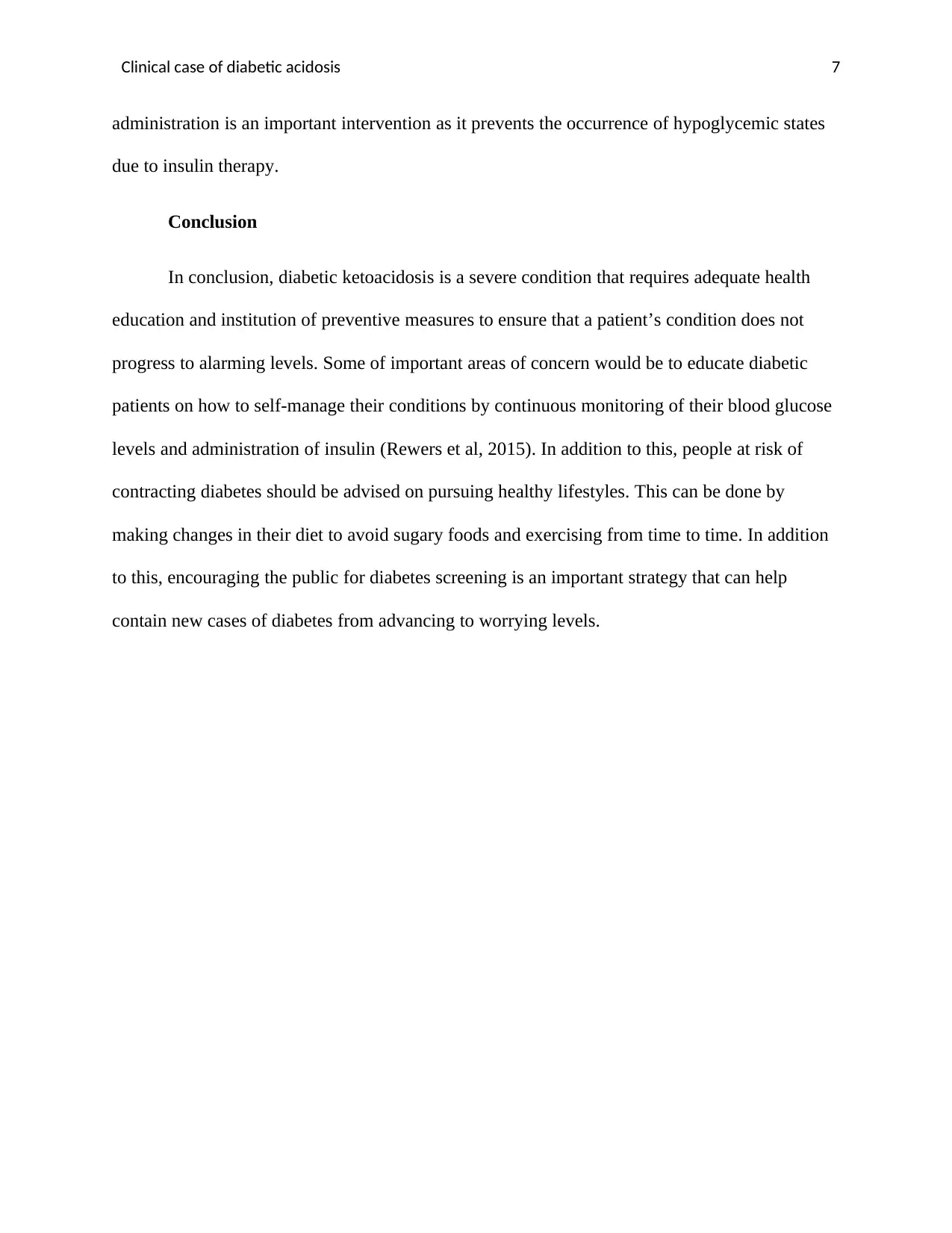
Clinical case of diabetic acidosis 7
administration is an important intervention as it prevents the occurrence of hypoglycemic states
due to insulin therapy.
Conclusion
In conclusion, diabetic ketoacidosis is a severe condition that requires adequate health
education and institution of preventive measures to ensure that a patient’s condition does not
progress to alarming levels. Some of important areas of concern would be to educate diabetic
patients on how to self-manage their conditions by continuous monitoring of their blood glucose
levels and administration of insulin (Rewers et al, 2015). In addition to this, people at risk of
contracting diabetes should be advised on pursuing healthy lifestyles. This can be done by
making changes in their diet to avoid sugary foods and exercising from time to time. In addition
to this, encouraging the public for diabetes screening is an important strategy that can help
contain new cases of diabetes from advancing to worrying levels.
administration is an important intervention as it prevents the occurrence of hypoglycemic states
due to insulin therapy.
Conclusion
In conclusion, diabetic ketoacidosis is a severe condition that requires adequate health
education and institution of preventive measures to ensure that a patient’s condition does not
progress to alarming levels. Some of important areas of concern would be to educate diabetic
patients on how to self-manage their conditions by continuous monitoring of their blood glucose
levels and administration of insulin (Rewers et al, 2015). In addition to this, people at risk of
contracting diabetes should be advised on pursuing healthy lifestyles. This can be done by
making changes in their diet to avoid sugary foods and exercising from time to time. In addition
to this, encouraging the public for diabetes screening is an important strategy that can help
contain new cases of diabetes from advancing to worrying levels.
Paraphrase This Document
Need a fresh take? Get an instant paraphrase of this document with our AI Paraphraser
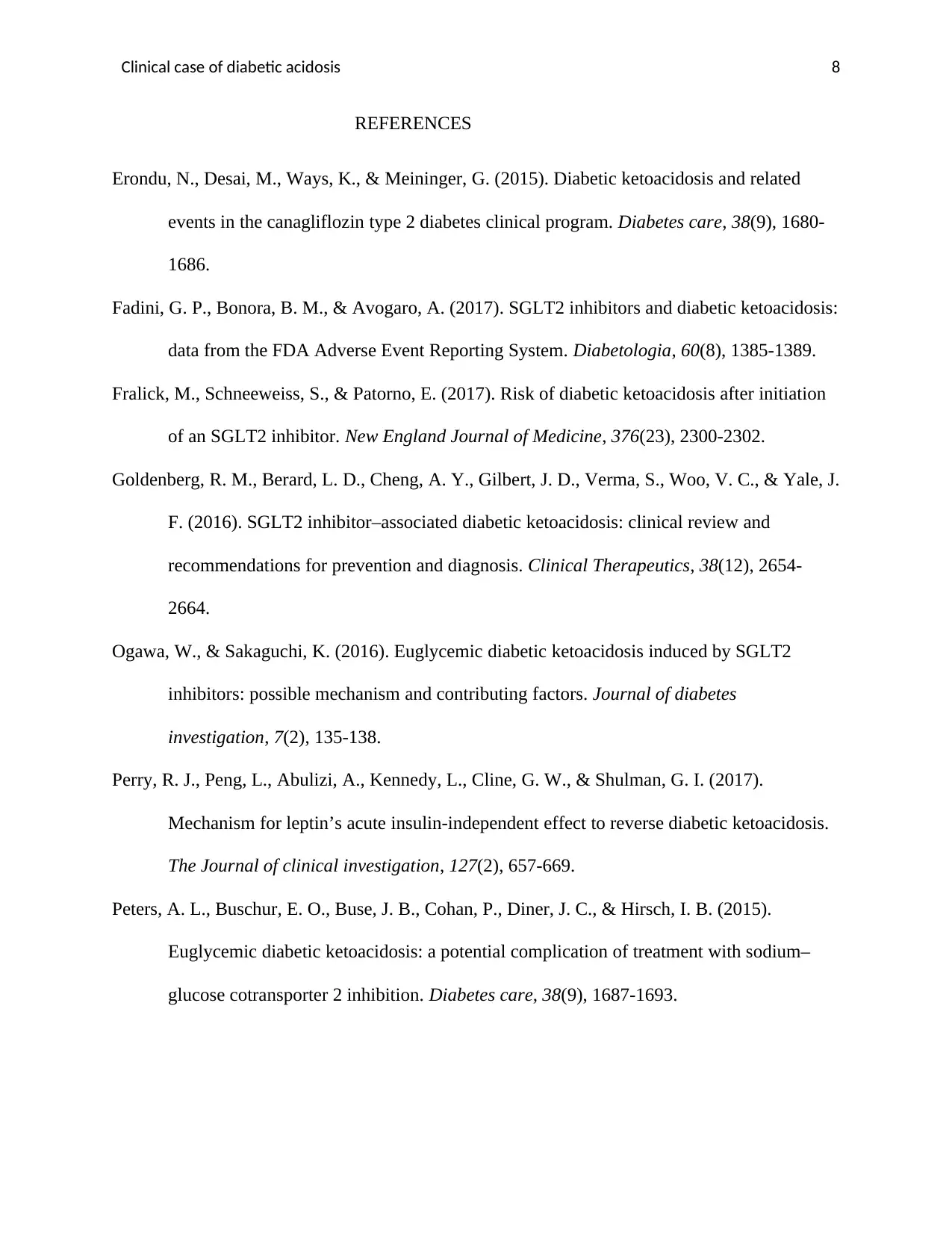
Clinical case of diabetic acidosis 8
REFERENCES
Erondu, N., Desai, M., Ways, K., & Meininger, G. (2015). Diabetic ketoacidosis and related
events in the canagliflozin type 2 diabetes clinical program. Diabetes care, 38(9), 1680-
1686.
Fadini, G. P., Bonora, B. M., & Avogaro, A. (2017). SGLT2 inhibitors and diabetic ketoacidosis:
data from the FDA Adverse Event Reporting System. Diabetologia, 60(8), 1385-1389.
Fralick, M., Schneeweiss, S., & Patorno, E. (2017). Risk of diabetic ketoacidosis after initiation
of an SGLT2 inhibitor. New England Journal of Medicine, 376(23), 2300-2302.
Goldenberg, R. M., Berard, L. D., Cheng, A. Y., Gilbert, J. D., Verma, S., Woo, V. C., & Yale, J.
F. (2016). SGLT2 inhibitor–associated diabetic ketoacidosis: clinical review and
recommendations for prevention and diagnosis. Clinical Therapeutics, 38(12), 2654-
2664.
Ogawa, W., & Sakaguchi, K. (2016). Euglycemic diabetic ketoacidosis induced by SGLT2
inhibitors: possible mechanism and contributing factors. Journal of diabetes
investigation, 7(2), 135-138.
Perry, R. J., Peng, L., Abulizi, A., Kennedy, L., Cline, G. W., & Shulman, G. I. (2017).
Mechanism for leptin’s acute insulin-independent effect to reverse diabetic ketoacidosis.
The Journal of clinical investigation, 127(2), 657-669.
Peters, A. L., Buschur, E. O., Buse, J. B., Cohan, P., Diner, J. C., & Hirsch, I. B. (2015).
Euglycemic diabetic ketoacidosis: a potential complication of treatment with sodium–
glucose cotransporter 2 inhibition. Diabetes care, 38(9), 1687-1693.
REFERENCES
Erondu, N., Desai, M., Ways, K., & Meininger, G. (2015). Diabetic ketoacidosis and related
events in the canagliflozin type 2 diabetes clinical program. Diabetes care, 38(9), 1680-
1686.
Fadini, G. P., Bonora, B. M., & Avogaro, A. (2017). SGLT2 inhibitors and diabetic ketoacidosis:
data from the FDA Adverse Event Reporting System. Diabetologia, 60(8), 1385-1389.
Fralick, M., Schneeweiss, S., & Patorno, E. (2017). Risk of diabetic ketoacidosis after initiation
of an SGLT2 inhibitor. New England Journal of Medicine, 376(23), 2300-2302.
Goldenberg, R. M., Berard, L. D., Cheng, A. Y., Gilbert, J. D., Verma, S., Woo, V. C., & Yale, J.
F. (2016). SGLT2 inhibitor–associated diabetic ketoacidosis: clinical review and
recommendations for prevention and diagnosis. Clinical Therapeutics, 38(12), 2654-
2664.
Ogawa, W., & Sakaguchi, K. (2016). Euglycemic diabetic ketoacidosis induced by SGLT2
inhibitors: possible mechanism and contributing factors. Journal of diabetes
investigation, 7(2), 135-138.
Perry, R. J., Peng, L., Abulizi, A., Kennedy, L., Cline, G. W., & Shulman, G. I. (2017).
Mechanism for leptin’s acute insulin-independent effect to reverse diabetic ketoacidosis.
The Journal of clinical investigation, 127(2), 657-669.
Peters, A. L., Buschur, E. O., Buse, J. B., Cohan, P., Diner, J. C., & Hirsch, I. B. (2015).
Euglycemic diabetic ketoacidosis: a potential complication of treatment with sodium–
glucose cotransporter 2 inhibition. Diabetes care, 38(9), 1687-1693.

Clinical case of diabetic acidosis 9
Rewers, A., Dong, F., Slover, R. H., Klingensmith, G. J., & Rewers, M. (2015). Incidence of
diabetic ketoacidosis at diagnosis of type 1 diabetes in Colorado youth, 1998-2012. Jama,
313(15), 1570-1572.
Rosenstock, J., & Ferrannini, E. (2015). Euglycemic diabetic ketoacidosis: a predictable,
detectable, and preventable safety concern with SGLT2 inhibitors. Diabetes care, 38(9),
1638-1642.
Sharma, P. V., Jobanputra, Y. B., Lewin, K., Bagatell, S., & Lichtstein, D. M. (2018). Diabetic
ketoacidosis in patients with type 2 diabetes on sodium-glucose cotransporter-2
inhibitors-a case series. Reviews on recent clinical trials, 13(2), 156-160.
Taylor, S. I., Blau, J. E., & Rother, K. I. (2015). SGLT2 inhibitors may predispose to
ketoacidosis. The Journal of Clinical Endocrinology & Metabolism, 100(8), 2849-2852.
Umpierrez, G., & Korytkowski, M. (2016). Diabetic emergencies—ketoacidosis,
hyperglycaemic hyperosmolar state and hypoglycaemia. Nature reviews Endocrinology,
12(4), 222.
Rewers, A., Dong, F., Slover, R. H., Klingensmith, G. J., & Rewers, M. (2015). Incidence of
diabetic ketoacidosis at diagnosis of type 1 diabetes in Colorado youth, 1998-2012. Jama,
313(15), 1570-1572.
Rosenstock, J., & Ferrannini, E. (2015). Euglycemic diabetic ketoacidosis: a predictable,
detectable, and preventable safety concern with SGLT2 inhibitors. Diabetes care, 38(9),
1638-1642.
Sharma, P. V., Jobanputra, Y. B., Lewin, K., Bagatell, S., & Lichtstein, D. M. (2018). Diabetic
ketoacidosis in patients with type 2 diabetes on sodium-glucose cotransporter-2
inhibitors-a case series. Reviews on recent clinical trials, 13(2), 156-160.
Taylor, S. I., Blau, J. E., & Rother, K. I. (2015). SGLT2 inhibitors may predispose to
ketoacidosis. The Journal of Clinical Endocrinology & Metabolism, 100(8), 2849-2852.
Umpierrez, G., & Korytkowski, M. (2016). Diabetic emergencies—ketoacidosis,
hyperglycaemic hyperosmolar state and hypoglycaemia. Nature reviews Endocrinology,
12(4), 222.
⊘ This is a preview!⊘
Do you want full access?
Subscribe today to unlock all pages.

Trusted by 1+ million students worldwide
1 out of 9
Related Documents
Your All-in-One AI-Powered Toolkit for Academic Success.
+13062052269
info@desklib.com
Available 24*7 on WhatsApp / Email
![[object Object]](/_next/static/media/star-bottom.7253800d.svg)
Unlock your academic potential
Copyright © 2020–2025 A2Z Services. All Rights Reserved. Developed and managed by ZUCOL.





